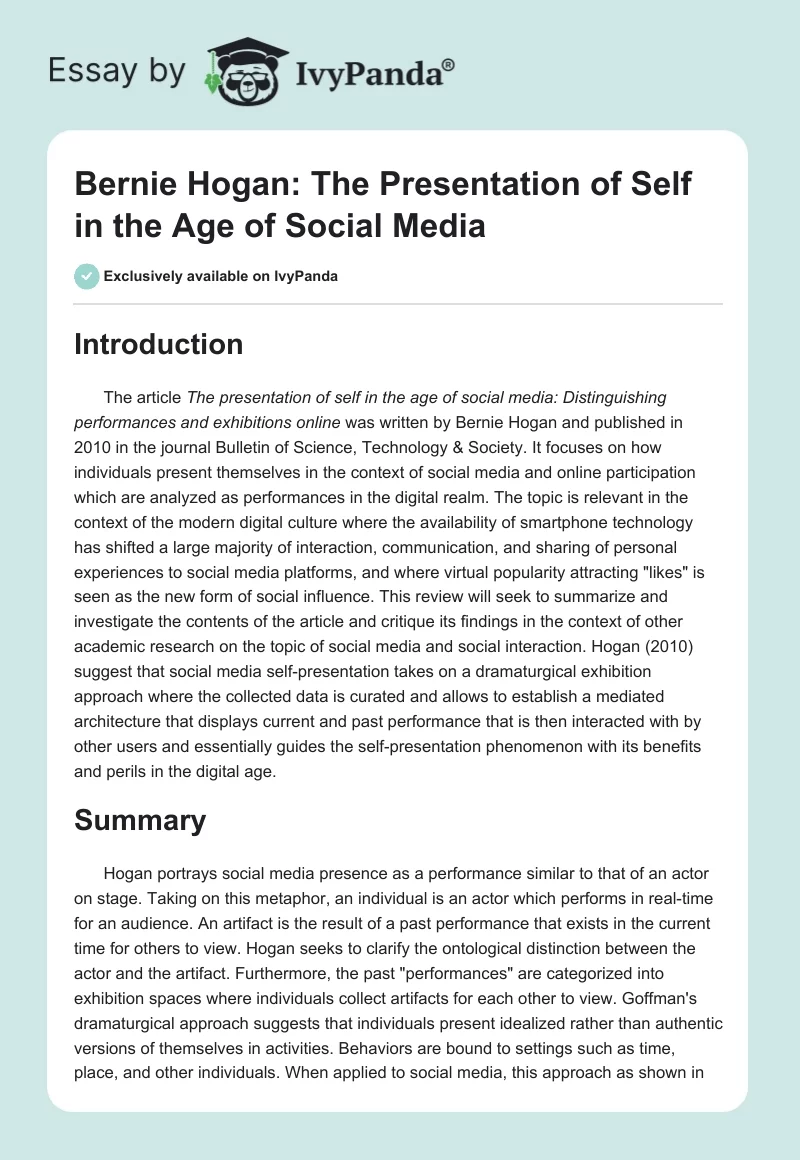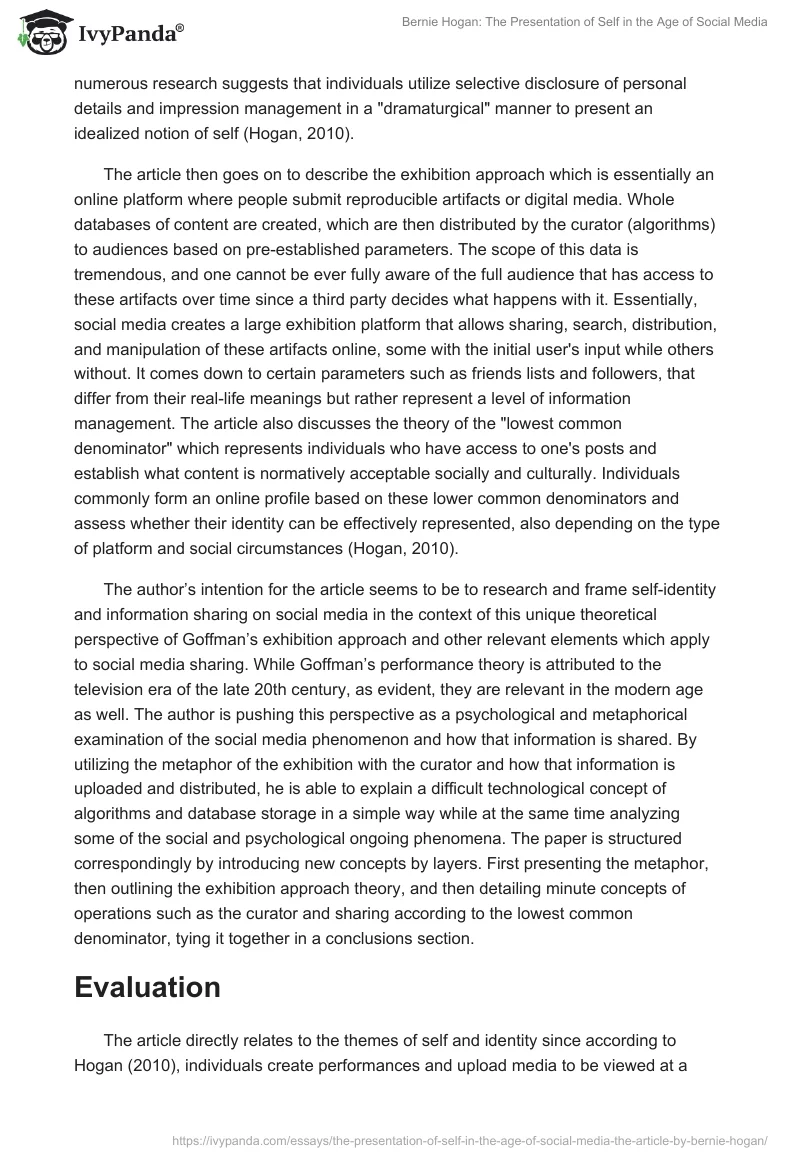Introduction
The article The presentation of self in the age of social media: Distinguishing performances and exhibitions online was written by Bernie Hogan and published in 2010 in the journal Bulletin of Science, Technology & Society. It focuses on how individuals present themselves in the context of social media and online participation which are analyzed as performances in the digital realm. The topic is relevant in the context of the modern digital culture where the availability of smartphone technology has shifted a large majority of interaction, communication, and sharing of personal experiences to social media platforms, and where virtual popularity attracting “likes” is seen as the new form of social influence. This review will seek to summarize and investigate the contents of the article and critique its findings in the context of other academic research on the topic of social media and social interaction. Hogan (2010) suggest that social media self-presentation takes on a dramaturgical exhibition approach where the collected data is curated and allows to establish a mediated architecture that displays current and past performance that is then interacted with by other users and essentially guides the self-presentation phenomenon with its benefits and perils in the digital age.
Summary
Hogan portrays social media presence as a performance similar to that of an actor on stage. Taking on this metaphor, an individual is an actor which performs in real-time for an audience. An artifact is the result of a past performance that exists in the current time for others to view. Hogan seeks to clarify the ontological distinction between the actor and the artifact. Furthermore, the past “performances” are categorized into exhibition spaces where individuals collect artifacts for each other to view. Goffman’s dramaturgical approach suggests that individuals present idealized rather than authentic versions of themselves in activities. Behaviors are bound to settings such as time, place, and other individuals. When applied to social media, this approach as shown in numerous research suggests that individuals utilize selective disclosure of personal details and impression management in a “dramaturgical” manner to present an idealized notion of self (Hogan, 2010).
The article then goes on to describe the exhibition approach which is essentially an online platform where people submit reproducible artifacts or digital media. Whole databases of content are created, which are then distributed by the curator (algorithms) to audiences based on pre-established parameters. The scope of this data is tremendous, and one cannot be ever fully aware of the full audience that has access to these artifacts over time since a third party decides what happens with it. Essentially, social media creates a large exhibition platform that allows sharing, search, distribution, and manipulation of these artifacts online, some with the initial user’s input while others without. It comes down to certain parameters such as friends lists and followers, that differ from their real-life meanings but rather represent a level of information management. The article also discusses the theory of the “lowest common denominator” which represents individuals who have access to one’s posts and establish what content is normatively acceptable socially and culturally. Individuals commonly form an online profile based on these lower common denominators and assess whether their identity can be effectively represented, also depending on the type of platform and social circumstances (Hogan, 2010).
The author’s intention for the article seems to be to research and frame self-identity and information sharing on social media in the context of this unique theoretical perspective of Goffman’s exhibition approach and other relevant elements which apply to social media sharing. While Goffman’s performance theory is attributed to the television era of the late 20th century, as evident, they are relevant in the modern age as well. The author is pushing this perspective as a psychological and metaphorical examination of the social media phenomenon and how that information is shared. By utilizing the metaphor of the exhibition with the curator and how that information is uploaded and distributed, he is able to explain a difficult technological concept of algorithms and database storage in a simple way while at the same time analyzing some of the social and psychological ongoing phenomena. The paper is structured correspondingly by introducing new concepts by layers. First presenting the metaphor, then outlining the exhibition approach theory, and then detailing minute concepts of operations such as the curator and sharing according to the lowest common denominator, tying it together in a conclusions section.
Evaluation
The article directly relates to the themes of self and identity since according to Hogan (2010), individuals create performances and upload media to be viewed at a later date by others as a representation of their identity. Users are constantly evaluating the social media platform, their uploads, and other users that see it are a good representation of their said identity. This matches research by Boyd and Ellison (2008) which indicates that social media profiles are unique pages where individuals can “type oneself into being” creating an identity (p. 211). Based on this created identity, users can match with each other based not only on social connections in real life but potentially commonalities in ethnicity, religion, sexual orientation, political affiliation, and other elements which inherently drive a person’s identity.
How does this tie into the process of forming an identity online? Hogan refers to algorithm curators who drive the social aspect to properly sharing these performances. However, research by Rui and Stefanone (2013) indicates that there is a strategic aspect to self-presentation online based on cultural aspects and audience diversity. They state that individuals update profiles based on what is better accepted in their respective cultures and in a manner, which would create the most positive acceptance and reactions. Users actively manage the information in order to influence self-presentation behaviors in accordance with their audience. This can be tied to Hogan’s concept of the least common denominator.
Nevertheless, identity shaping can take on many different forms and is strongly defined by the said curator or algorithm which shapes the narrative sometimes just as much if not more than the individual. For example, the app Carrot created an aspect of shaming and sexualizing attributes of women. The one-dimensionality of identity via the app created difficult social situations and potential harassment. Carrot created an intimate relationship between an individual and the app at the expense of an identity prosthesis which was developed based on stereotypes (Murray, 2018). Overall, it seems Hogan’s conclusions are correct and largely supported by other social media research that ties identity online to a complex juxtaposition of strategic performance and sharing algorithms.
Conclusion
Social media is a prevalent activity and method of exchanging information in the modern day where individuals often seek to control the narrative that is presented to the outside world about their lives. Taking this concept, Hogan (2010) applied a metaphorical analysis to the process using Goffman’s exhibition theory that outlines the concept of presentation and performance on social media, and how this information is stored and distributed by algorithms for one’s social media connections and later use. It is highly relevant to consider such topics, considering that other research largely supports the contexts described by Hogan and evaluates social media behaviors as well as certain social implications.
References
Boyd, D. M., & Ellison, N. B. (2008). Social network sites: Definition, history, and scholarship. Journal of Computer-Mediated Communication, 13(1), 210–230. Web.
Hogan, B. (2010). The presentation of self in the age of social media: Distinguishing performances and exhibitions online. Bulletin of Science, Technology & Society, 30(6), 377–386. Web.
Murray, S. (2018). Carrot. In J. W. Morris & S. Murray (Eds.), Appified (pp. 72-81). Ann Arbor, MI: University of Michigan Press.
Rui, J., & Stefanone, M. A. (2013). Strategic self-presentation online: A cross-cultural study. Computers in Human Behavior, 29(1), 110–118. Web.


